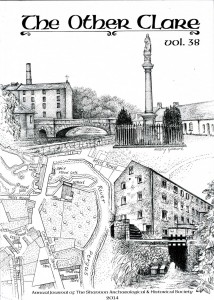THE first volume of The Other Clare was published by the Shannon Archaeological & Historical Society in 1977 and contained 34 pages dealing with historical aspects of south Clare. After it was produced, the hope was that there would be a second volume, and possibly some more.
However, in the intervening 37 years, over 2,500 pages containing over 680 articles on the historical heritage of County Clare have been published within its covers.
Volume 38 of The Other Clare was launched recently and this year’s journal follows the format of its predecessors containing a variety of articles by seasoned and new authors alike on a wide range of topics relating to the county’s heritage.
Risteard UaCroinin and Martin Breen continue their invaluable study of the county’s towerhouses, this time focusing on the restored Ballyhannon Castle, near Quin.
Martin Barry continues the study of Drinagh townland that he begun last year, this time focussing on the history of its landownership from medieval times up to the early 20th century.
 Edel Ruttle presents the findings of archaeological excavations near St. Finghin’s Parish Church in Quin, which resulted in the discovery of an intriguing skeleton, the remains of someone who liked a smoke while living.
Edel Ruttle presents the findings of archaeological excavations near St. Finghin’s Parish Church in Quin, which resulted in the discovery of an intriguing skeleton, the remains of someone who liked a smoke while living.
The prolific Luke McInerney provides an indepth and definitive study of the Clann Cruitin, or MacCurtin’s, who were chronicler-poets to the O’Briens in medieval times.
Mary Kearns casts her eye on some medieval graffiti in Ennis Friary, and speculates on who produced it and what it means.
Risteard UaCroinin tells us about Patrick Mullins, the scribe of a 19th century manuscript protected and treasured by a local Ennistymon woman, and provides an appendix which outlines the contents of the manuscript as catalogued by the Dublin Institute of Advanced Studies.
Edel Barry gives a fascinating account of the social history of the West Clare Railway Station at Lahinch, which opened up the town as a tourist destination in the 19th century.
In his article ‘Milling on the Fergus’, Brian Ó Dálaigh presents a comprehensive study of milling in the town of Ennis, from the earliest documentary sources in the 16th century to the dying days of a much changed industry in 1980.
Paddy Nolan, a seasoned contributor to the journal, gives his interpretation of the cause and effects of the sinking of the famine ship, The Edmond, in 1850. His article contains definitive set of appendices that will prove invaluable to all further researchers of the topic.
Six beautiful pen and ink sketches of castles in the county are published for the first time in Jane’s Castles Sketches, by Veronica Rowe and Martin Breen. Veronica outlines the background to the drawings executed by her mother Jane Vere O’Brien in the early part of the 20th century while Martin describes what the pictures show and notes any changes that have occurred in the castles or the landscape since they were first drawn.
Michael McNamara describes how the derelict Church of Ireland parish church of Clonrush has been transformed into the Kilkishen Cultural Centre, with sensitivity to the buildings past through maintaining its original features and artefacts.
Mary Hester discusses the contributions made by Ballynacally and Coney Island national schools to the 1930s Schools Folklore Scheme. She examines the variety of topics covered and reveals the value of these manuscripts to understanding the folk life alive in the county not that long ago.
And finally, Rosemary Power examines how Brian Ború and the Battle of Clontarf were recorded and remembered in the Nordic world where stories relating to both found their way into various histories and sagas.
As usual, the distinctive cover design is by Hilary Gilmore and it depicts historic buildings relating to the milling industry in Ennis.
The society invites contribtions of material for inclusion in The Other Clare, from both amateur historians and academic writers. It also organises an Autumn and Winter lectures series and visits to places of historic interest during the Summer months. New members are always welcome, irrespective of their level of knowledge of history or archaeology.
Further information on upcoming events can be found on: www.clareheritage.org or by contacting John O’Brien on 086-8501595.
A native of Ennis, Colin McGann has been editor of The Clare Champion since August 2020. Former editor of The Clare People, he is a journalism and communications graduate of Dublin Institute of Technology.



